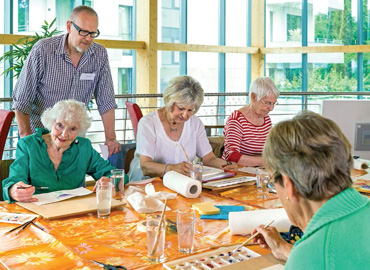
By Jennifer Sellers
Artistic expression can lead to enriching experiences for people with dementia.
Imagine a woman with reduced language skills being able to read poems before a group of her peers, or a former artist using a paintbrush again after years of refusing to pick it up. These are examples of the types of engagement Christina Hugenschmidt, PhD, assistant professor of gerontology and geriatric medicine at Wake Forest Baptist Medical Center in Winston-Salem, N.C., sees frequently in the creative intervention group she runs for people with dementia.
While such results don’t affect the progression of dementia, they do have a noticeable impact on the lives of those who suffer from it. Dr. Hugenschmidt says she’s observed numerous benefits the arts have on people with memory problems, including increases in confidence, social interaction, and mood. Some interventions, such as creative movement, can even help patients with balance and stability.
“The same neurodegenerative process that affects cognition, can spread to other regions of the brain and affect motor function as well,” says Dr. Hugenschmidt. She notes that any intervention that can affect balance, gait and walking can have a direct benefit for the person. It can also have an indirect benefit for caregivers, who have to deal with falls, transfers and other issues like that around the home.
Projects that Engage
Dr. Hugenschmidt’s group integrates a variety of artistic components, including dance, painting, photography, and poetry. Most participants are dementia patients who are mobile and still living at home with a caregiver. They range, she says, from those who are verbal and really want to talk about things to the lower functioning, who have trouble being verbal and making eye contact.
During a typical session, Christina Soriano, a professor of dance at Wake Forest University, will guide the participants through improvisational movement. Then, Dr. Hugenschmidt and a student assistant, Bryan Neth, will introduce an artistic activity to the class. For instance, the class will view and discuss iconic photographs.
The participants will often have the opportunity to extend the lesson into a home-based activity. So, for example, after the photography discussion, participants will be given disposable cameras to take home so that they can shoot their own photos. Dr. Hugenschmidt and her collaborators will develop the photos so that the class can discuss them.
“When we discuss iconic photos, it gives them a chance to recount memories and bond with one another,” she says. But participants can also consider what aspects of the images they like most—the contrast and placement, for example. They can even take their own photos, choosing what they personally find striking or interesting.
The projects often evolve. For instance, the participants could be asked to create haikus about the photographs. A session like this is where the woman in the introduction had an opportunity to read poems before the class. The woman had initially been insecure and nonverbal, but she started blossoming within the group.
“This woman was withdrawn and tends to have a lot of problems with language production,” says Dr. Hugenschmidt. The first time she walked into the group, Dr. Hugenschmidt recounts, she tried to follow her husband back out. Over time, however, she got involved in more activities. “Even though she struggled generating her own language, she was able to read the poems,” says Dr. Hugenschmidt. “Someone might say it’s not possible to run a group with participants like her, but when you take the time to learn more about them and give them different avenues of expression, they often come out of their shells.”
Seeing Results
In addition to the successes Dr. Hugenschmidt has observed, she’s also gotten a lot of positive feedback from patients and their caregivers. They’ve reported that they’ve enjoyed the activities, felt accepted, felt less self-conscious about their memory problems and were able to meet people with similar interests.
To get a more definitive idea of how the art classes are helping patients, Dr. Hugenschmidt’s team is looking at changes in physiological measures of stress, such as cortisol levels, to determine if participation is helping reduce anxiety and tension. While the data hasn’t yet been analyzed, Dr. Hugenschmidt is hopeful about the results. People with dementia tend to have elevated levels of cortisol, so the results of these tests will offer some insight into how art may be beneficial.
Getting Your Loved One Involved in the Arts
Most communities have similar types of resources. It’s a good idea to check with senior centers, local universities, and departments of aging. There are also online resources that can help you connect with a group near you. A good place to start is the National Center for Creative Aging. Their website, creativeaging.com, has a resources section that lists senior enrichment programs throughout the country, including many that offer services to people with dementia.
You can also engage your loved one at home, says Dr. Hugenschmidt. “One of our caregivers gives her husband old photographs to organize into a memory book,” she says. “He doesn’t get very far with it; he does a lot of it over and over again. However, he really enjoys it.”
Music is another important element to include in your loved one’s life. Purchase CDs of albums that were popular during key periods of his or her life. Consider paintings as well. If you’re buying a new piece of art for your home, narrow your selection down to two choices, and let your loved one choose which one you’ll get. Coloring is another option. Some craft stores have a selection of grown-up coloring books that can be used with markers and colored pencils.
“You might be surprised at the benefits of this,” says Dr. Hugenschmidt. “Art offers not only freedom of expression, but temporary freedom from the diagnosis. And by reducing stress on the patients, it can also help lighten the burden for caregivers. Art really reaches people in unlimited ways.”










